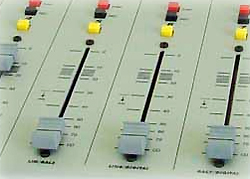Some of the most common questions from those researching mid- to large-format live sound consoles for their churches involve VCA groups.
What are they? How are they used? What are the benefits?
A VCA, or Voltage Controlled Amplifier, is an electronic device in the form of an integrated circuit, or chip, that sits in the audio circuit of each input channel in a mixing console.
The audio signal through each input channel passes via the VCA, which controls the level of that signal based on a DC voltage applied to it from an external controller such as a fader.
Unlike a conventional console, the channel fader in a VCA console does not pass audio, instead controlling the VCA in the input channel circuit. This offers several advantages, one of which is that it drastically cuts down on the wear and tear normally associated with standard analog faders.
A conventional fader is essentially a resistive circuit, like a rotary level control stretched out into a straight line, or a lighting rheostat. Constant use of a conventional fader, which passes the actual channel signal, leads to a deterioration of the fader’s resistive surface, requiring it to be carefully maintained and eventually, more than likely, replaced.
In a VCA console, noise filtering may be applied to a VCA fader circuit to reduce the audible effects of fader wear.
VCAs are by no means new. They are also used in outboard signal processing devices such as compressors, limiters, and noise gates, where circuitry acts on VCAs to produce the desired effect.
And they are not new to consoles, either, having originally been fitted into high-end recording studio consoles, where mix automation systems recorded and played back the voltage changes at each input channel VCA using a computer synchronized to timecode on the multitrack tape.
Except for elaborate Broadway-style shows, live sound consoles generally do not benefit from timecode-based automation. But VCA control is most definitely beneficial.
Since each input channel VCA responds to an external DC voltage the signal level can be controlled not only by its respective channel fader but by other faders as well. That has allowed the development of VCA group faders, dedicated faders in the center section to which input channels may be assigned, in much the same way as conventional audio subgroups.
Compared to recording consoles, VCA technology has only relatively recently been applied to live sound consoles, especially large desks suitable for major touring applications, where the ability to create VCA subgroups, plus the associated muting functionality, is extraordinarily useful.
As the technology has matured it has trickled down to become more commonplace in live consoles that are within the budget of many churches.
So how do VCA groups differ from audio subgroups?
Assigning an input channel to an audio subgroup sends the signal through a bus to the group channel with its associated gain stage, subgroup fader, and output connector, plus, on some consoles, effects insert connectors.
Since no audio passes through a VCA fader, a VCA group fader simply acts as a control device for the channels assigned to it.




















